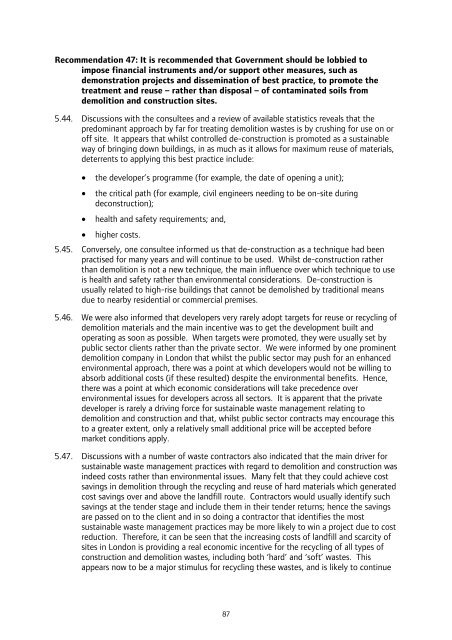London Wider Waste Strategy - London - Greater London Authority
London Wider Waste Strategy - London - Greater London Authority
London Wider Waste Strategy - London - Greater London Authority
You also want an ePaper? Increase the reach of your titles
YUMPU automatically turns print PDFs into web optimized ePapers that Google loves.
Recommendation 47: It is recommended that Government should be lobbied to<br />
impose financial instruments and/or support other measures, such as<br />
demonstration projects and dissemination of best practice, to promote the<br />
treatment and reuse – rather than disposal – of contaminated soils from<br />
demolition and construction sites.<br />
5.44. Discussions with the consultees and a review of available statistics reveals that the<br />
predominant approach by far for treating demolition wastes is by crushing for use on or<br />
off site. It appears that whilst controlled de-construction is promoted as a sustainable<br />
way of bringing down buildings, in as much as it allows for maximum reuse of materials,<br />
deterrents to applying this best practice include:<br />
• the developer’s programme (for example, the date of opening a unit);<br />
• the critical path (for example, civil engineers needing to be on-site during<br />
deconstruction);<br />
• health and safety requirements; and,<br />
• higher costs.<br />
5.45. Conversely, one consultee informed us that de-construction as a technique had been<br />
practised for many years and will continue to be used. Whilst de-construction rather<br />
than demolition is not a new technique, the main influence over which technique to use<br />
is health and safety rather than environmental considerations. De-construction is<br />
usually related to high-rise buildings that cannot be demolished by traditional means<br />
due to nearby residential or commercial premises.<br />
5.46. We were also informed that developers very rarely adopt targets for reuse or recycling of<br />
demolition materials and the main incentive was to get the development built and<br />
operating as soon as possible. When targets were promoted, they were usually set by<br />
public sector clients rather than the private sector. We were informed by one prominent<br />
demolition company in <strong>London</strong> that whilst the public sector may push for an enhanced<br />
environmental approach, there was a point at which developers would not be willing to<br />
absorb additional costs (if these resulted) despite the environmental benefits. Hence,<br />
there was a point at which economic considerations will take precedence over<br />
environmental issues for developers across all sectors. It is apparent that the private<br />
developer is rarely a driving force for sustainable waste management relating to<br />
demolition and construction and that, whilst public sector contracts may encourage this<br />
to a greater extent, only a relatively small additional price will be accepted before<br />
market conditions apply.<br />
5.47. Discussions with a number of waste contractors also indicated that the main driver for<br />
sustainable waste management practices with regard to demolition and construction was<br />
indeed costs rather than environmental issues. Many felt that they could achieve cost<br />
savings in demolition through the recycling and reuse of hard materials which generated<br />
cost savings over and above the landfill route. Contractors would usually identify such<br />
savings at the tender stage and include them in their tender returns; hence the savings<br />
are passed on to the client and in so doing a contractor that identifies the most<br />
sustainable waste management practices may be more likely to win a project due to cost<br />
reduction. Therefore, it can be seen that the increasing costs of landfill and scarcity of<br />
sites in <strong>London</strong> is providing a real economic incentive for the recycling of all types of<br />
construction and demolition wastes, including both ‘hard’ and ‘soft’ wastes. This<br />
appears now to be a major stimulus for recycling these wastes, and is likely to continue<br />
87
















